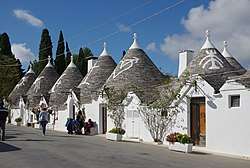Alberobello
| Alberobello | ||
|---|---|---|
| Comune | ||
| Comune di Alberobello | ||
|
Three trulli | ||
| ||
 Alberobello Location of Alberobello in Italy | ||
| Coordinates: 40°47′N 17°14′E / 40.783°N 17.233°E | ||
| Country | Italy | |
| Region |
| |
| Province / Metropolitan city | Bari (BA) | |
| Frazioni | Coreggia, Pantanelli, San Leonardo | |
| Government | ||
| • Mayor | Michele Maria Longo [1] | |
| Area | ||
| • Total | 40 km2 (20 sq mi) | |
| Elevation | 416 m (1,365 ft) | |
| Population (1-1-2017) | ||
| • Total | 10,735 | |
| • Density | 270/km2 (700/sq mi) | |
| Demonym(s) | Alberobellese(i) | |
| Time zone | CET (UTC+1) | |
| • Summer (DST) | CEST (UTC+2) | |
| Postal code | 70011 | |
| Dialing code | 080 | |
| Patron saint | Saints Cosmas and Damian | |
| Saint day | 27 September | |
| Website | Official website | |
| UNESCO World Heritage Site | ||
| Official name | The Trulli of Alberobello | |
| Criteria |
Cultural: (iii), (iv), (v) | |
| Reference | 787 | |
| Inscription | 1996 (20th Session) | |
Alberobello (Italian: [ˌalberoˈbɛllo]; literally "beautiful tree") is a small town and comune of the Metropolitan City of Bari, Apulia, southern Italy. It has 10 735 inhabitants and is famous for its unique trullo buildings. The trulli of Alberobello have been designated as a UNESCO World Heritage site since 1996.
History
Alberobello was first mentioned in the early 16th century when the first 40 families were granted land to farm in the area. The abundance of calcareous sedimentary material in the area lead to the building of houses with dry stone without the use of mortar. These houses were the first trulli which contributed to the expansion of the settlement. Building the houses of dry stone was a requirement of Count Giangirolamo II as in this way it was avoidable to pay taxes on them. The inhabitants of Alberobello were feudal vassals of the Acquaviva of Aragon until May 27, 1797, when King Ferdinand IV of Bourbon received Alberobello and issued a decree that elevated the small village to a royal city, freeing them from feudal serfdom.
The Trulli of Alberobello
.jpg)
The limestone conical structures, are examples of dry stacked construction. Corbelling is a pre-historic technique. The structures date from around the 14th century. Two districts of the city have the largest numbers of trulli: Rione Monti has 1,030 trulli, and Rione Aia Piccola has 590 trulli.[2]
International relations

Alberobello is twinned with:
 Shirakawa-go, Japan
Shirakawa-go, Japan Gokayama, Japan
Gokayama, Japan Monte Sant'Angelo, Italy, since 2013
Monte Sant'Angelo, Italy, since 2013 Andria, Italy
Andria, Italy Harran, Turkey, since 2013
Harran, Turkey, since 2013
References
- ↑ http://www.comune.alberobello.ba.it/index.php?option=com_content&view=article&id=25&Itemid=26&skin=white&size=%%
- ↑ Centre, UNESCO World Heritage. "The Trulli of Alberobello". whc.unesco.org. Retrieved 2017-07-07.
External links
| Wikivoyage has a travel guide for Alberobello. |
| Wikimedia Commons has media related to Alberobello. |


